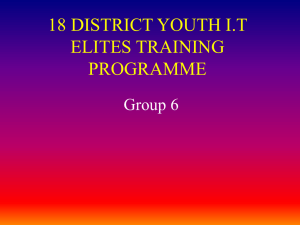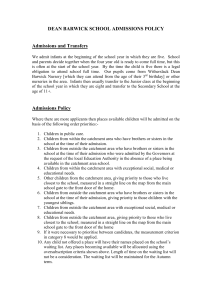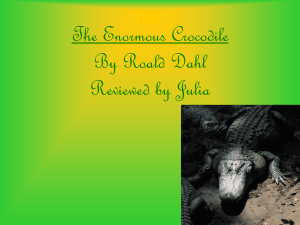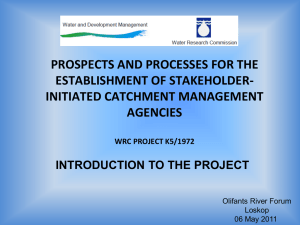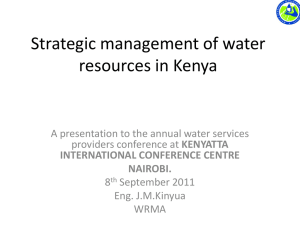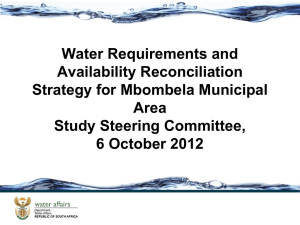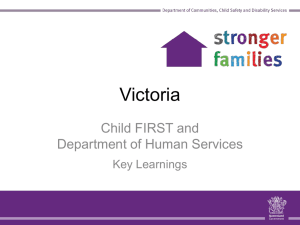WaterQuality
advertisement
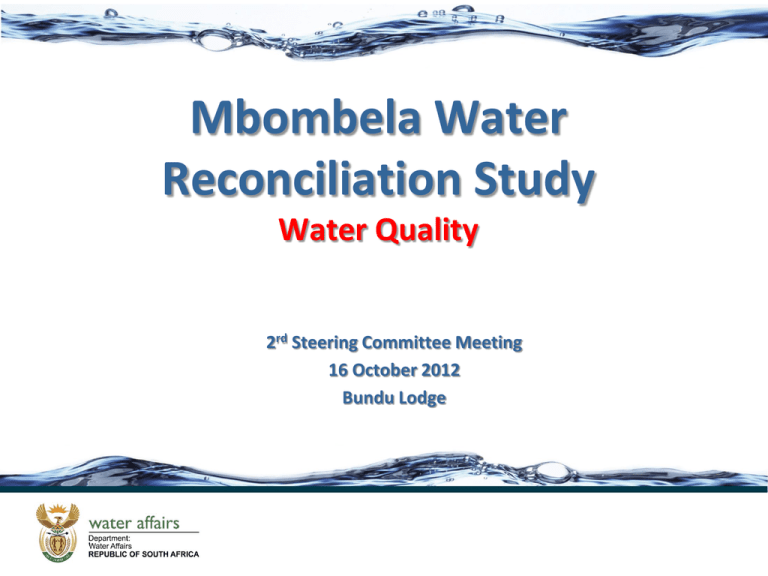
Mbombela Water Reconciliation Study Water Quality 2rd Steering Committee Meeting 16 October 2012 Bundu Lodge Objectives Ensure that the water reconciliation strategy for Mbombela satisfies the quality requirements of all relevant water users. More Specific Objectives for WQality • Identify triggers which may have an effect on water quality • Identify water users • Evaluate current water quality and observe trends • Compare ambient water quality with user requirements (RWQO) • Reconcile quality quantity and user requirements General land Use in the Crocodile River • Forestry - the western half of the catchment, has the largest number of plantations. • Dry land agriculture - these activities are located primarily in the central parts of the catchment and take the form of maize, subtropical fruits, nuts, citrus, coffee and vegetable cultivation. • Irrigated agriculture - the primary crops grown include maize, citrus, tobacco, sugar- cane and subtropical fruits sugar-cane and citrus being the most important. The largest areas of irrigation are located in the central and eastern regions of the catchment. General land Use in the Crocodile River (2) • Nature conservation - the major area of nature conservation activity in the catchment occurs within the southern portion of the Kruger National Park. • Mining and quarrying - the majority of mining activity has occurred along the Kaap River and to some degree in the lower Crocodile River. • Domestic and industrial land use - the towns of Nelspruit and White River are the focus of domestic and industrial land use in the catchment, with smaller centres at strategic points across the catchment. The Sappi paper mill is situated at Ngodwana next to the Elands River. Sawmill in Graskop and Smelter in Machadodorp Water Quality Impacts • Elands River – Upper Elands River have generally good quality water all year round. However, trout farming and sewage treatment plants has been identified as a source of eutrophication. – Ferro-chrome smelter at Machadodorp – Downstream in the Elands River, high electrical conductivity concentrations occur due to the presence of Sappi at the confluence with the Ngodwana River Water Quality Impacts (2) • Montrose to Nelspruit, – Afforestation in the catchment of the Nels River causes an increase in manganese background values, an increase in sediment loads and a decrease in pH values during logging operations. – Agricultural runoff here is related to increases in electrical conductivity, trace elements and nutrients. – Diffuse source releases from Papas Quarry at the confluence with the Gladdespruit , is a source of increased manganese concentrations in the Crocodile River. Water Quality Impacts (3) • Nelspruit to the confluence with the Kaap River – is associated with domestic runoff, littering and an increase in nutrients. Industrial effluents from Nelspruit cause an increase in manganese concentrations, while major – sewage treatment works at the towns of Nelspruit, Matsulu and Nkayamazane are sources of high nutrient loads in the river. Water Quality Impacts (4) • The Kaap River – has a potential impact on the lower Crocodile River due to agricultural runoff (increases in pesticides, trace elements and nutrients). – Mining activities have a high impact on water quality in this river during low flows (increases in sulphate, electrical conductivity, iron, zinc, arsenic and cyanide, and a decrease in pH) Water Quality Impacts (5) • The Sabie Sand River – Forestry activities close to or within the riparian zone are the primary threat to health of the riparian habitats and vegetation. – Trout is a threat to in-stream ecological health, through diversion of water for dams and weirs, which impact on the water flows in the area. Rivers may become enriched with nutrients from fish feed and waste. Water Quality Impacts (6) North Sand River • Typical impacts on water quality from rural and informal settlements relate to poorly managed or absent sanitation systems, littering and solid wastes being washed into the rivers and streams. Elevated nutrients and bacteriological • Small scale agriculture which takes place may result in an increase of pesticides and nutrients from fertilisers in the rivers. • Water is impacted by both waste water treatment plant discharges and diffuse pollution from rural and informal settlements due to poorly managed or absence of sanitation systems. Water Quality In general, a progressive decrease in water quality occurs in the river with increasing distance downstream. Waste Water Treatment Works • 7 WWTW ( Kingstonvale, Kabokweni, White River, Hazyview, Matsulu, Rockys Drift, Waterval Boven) • Compliance to Water Quality Discharge Standards are very poor. • Microbiological > Chemical • Only Hazyview is operated above capacity Green Drops Green Drops 2 RWQO • RWQO is the water quality component of the Resource Quality Objectives (RQOs). – numeric or descriptive in-stream (or in-aquifer) water quality objectives – finer resolution (spatial or temporal) than RQOs • Levels – Target, Acceptable, Tolerable, Unacceptable Reserve Crocodile X22B, X 22C X22J Parameterr Ecological Reserve Basic Human Needs Reserve Water Quality Reserve TDS Na Mg K Ca Cl SO4 Soluble Phosphate Total Inorganic Nitrate: Soluble Phospate ≤ 254 ≤ 30 ≤ 19 ≤ 1.1 ≤ 20 ≤ 18 ≤14 ≤ 0.055 >33.1 ≤ 1000 ≤ 200 ≤ 100 ≤ 50 ≤ 150 ≤ 200 ≤400 N/A N/A ≤ 254 ≤ 30 ≤ 19 ≤ 1.1 ≤ 20 ≤ 18 ≤14 ≤0.055 >33.1 pH DO % Ammonia (mg N/l as NH3) 5.6 - 8.1 >100 95% < 0.015 5 -9.5 N/A N/A Fe Al Mn 42 95% < 20 and 99% < 150 95% < 370 and 99% < 1300 TWQR Cr (VI) Cr (III) Zn Cu Cd As CN Cl 95% < 14 and 99% < 200 95% < 24 and 99% < 340 95% < 3.6 and 99% < 36 95% < 1.5 and 99% < 4.6 95% < 0.5 and 99% < 6 95% < 20 and 99% < 130 95% < 4 and 99% < 110 95% < 0.35 and 99% < 5 6. -8.1 >100 95% < 0.015 95% < 20 and 99% < 150 95% < 370 and 99% < 1300 95% < 14 and 99% < 200 95% < 24 and 99% < 340 95% < 3.6 and 99% < 36 95% < 1.5 and 99% < 4.6 95% < 0.5 and 99% < 6 95% < 20 and 99% < 130 95% < 4 and 99% < 110 95% < 0.35 and 99% < 5 Way Forward • What water uses are impacting on the water quality? • Who is using the water? • What water quality will be acceptable? • What is the current water quality and what trends do we observe? • Reconcile current qualities with user requirements = RWQO ? • How can this results influence the Mbombela Water Reconciliation Strategy? Way Forward (2) Gaps • Water Quality Monitoring Data limited (spatial information and parameters) • RWQO be set at desk top level with the purpose of guiding this project only – no public participation • Classification of rivers not yet finalised

